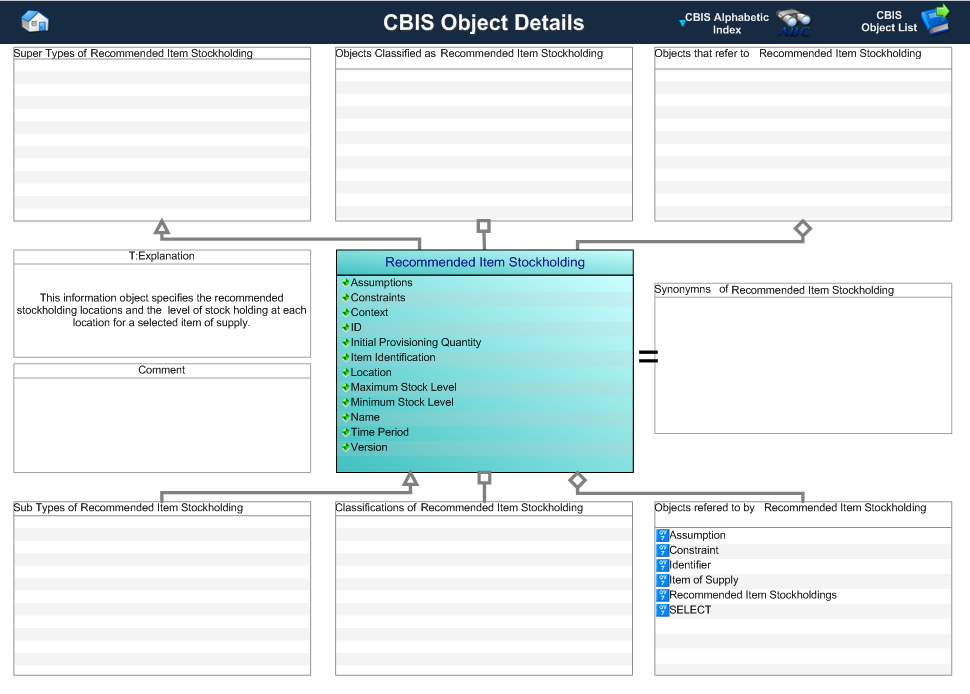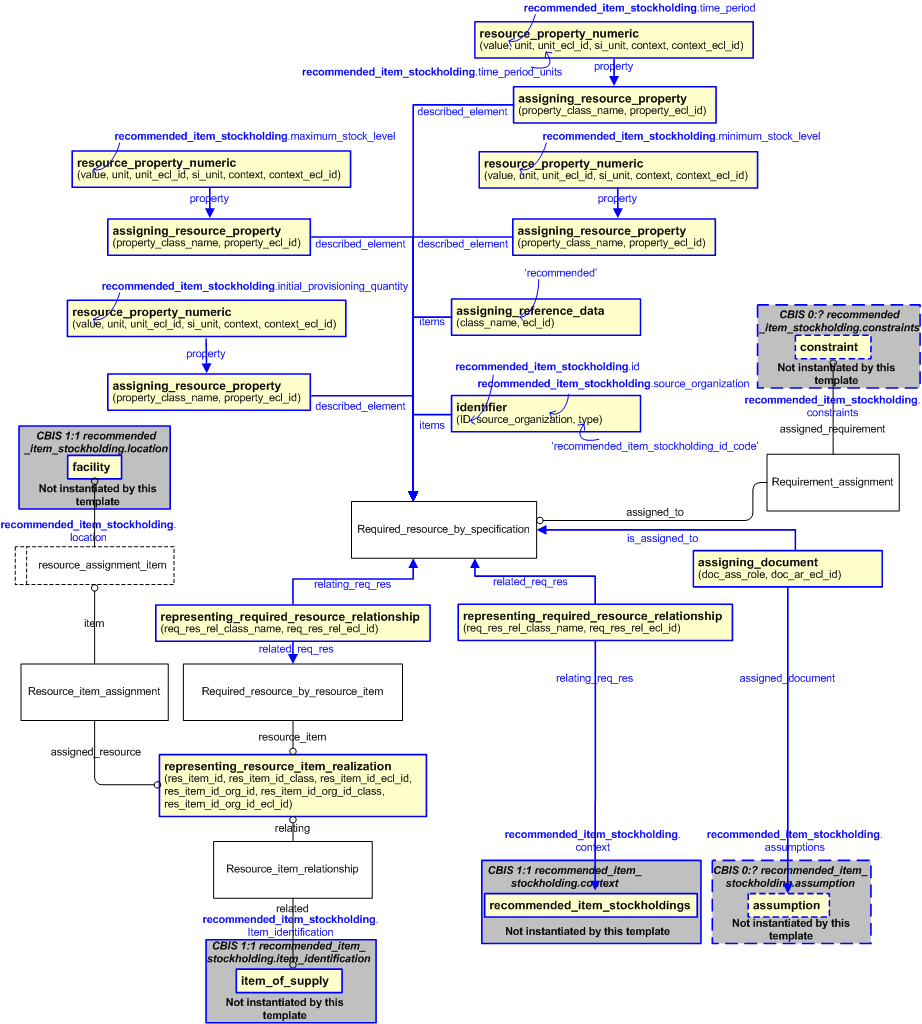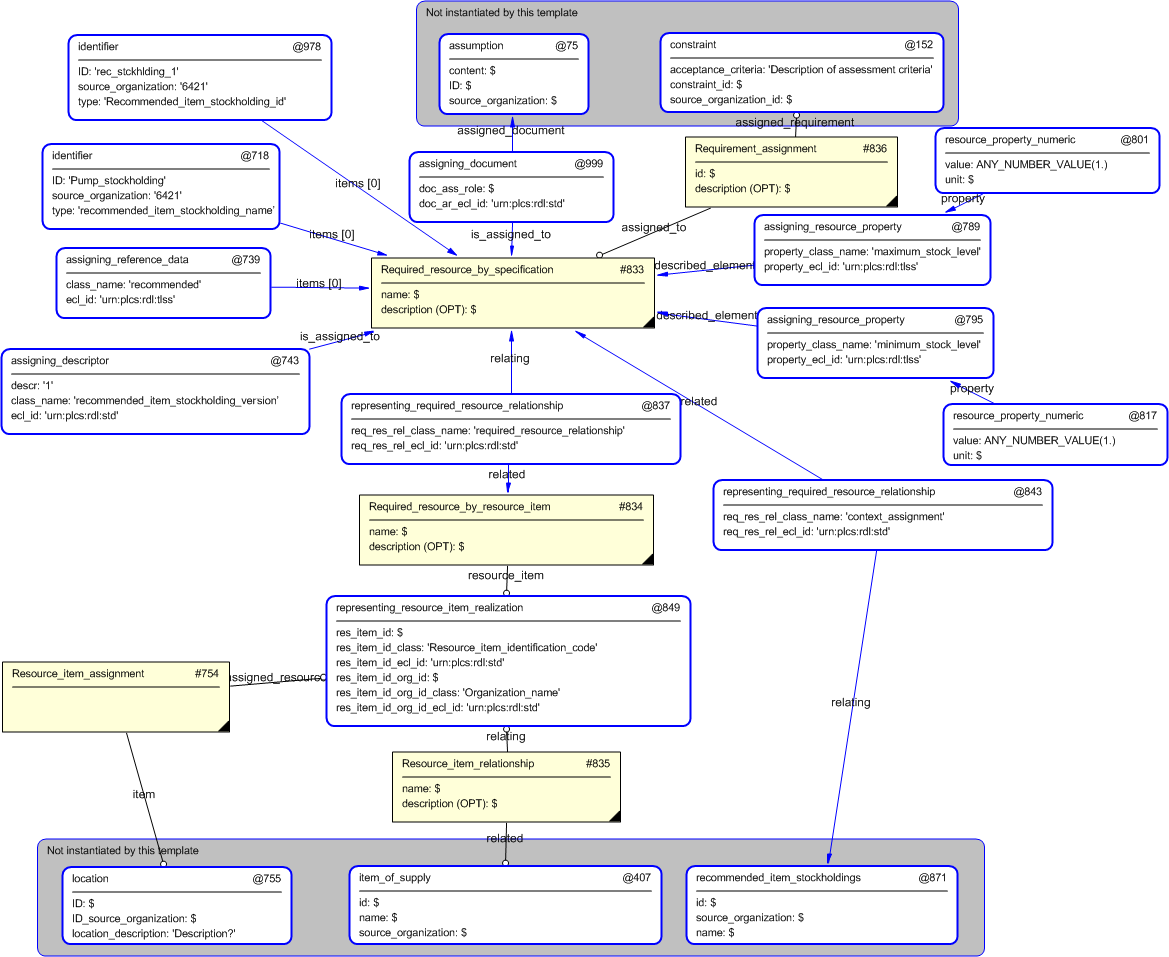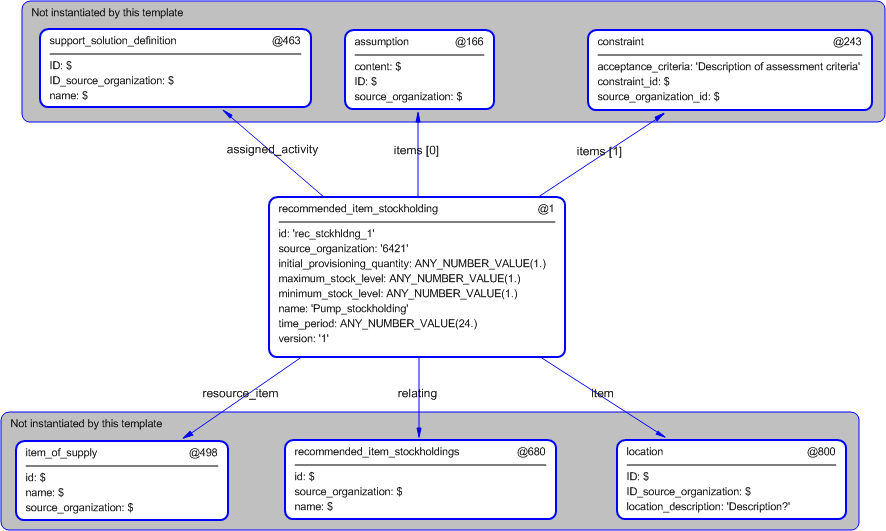This section specifies the template recommended_item_stockholding.
NOTE
The template has been defined in the context of
UK_Defence.
Refer to the business context for details of related templates.
NOTE
An explanation of a template and the associated instantiation path is
provided in the
Template overview
section.
The following input parameters are defined for this template:
The following reference parameters are defined for this template:
The instantiation path shown below specifies the entities that are to be
instantiated by the template.
-- required resource Required_resource_by_specification%^req_res_by_spec =
Required_resource_by_specification%
-- item of supply resource item /
representing_resource_item_realization(
res_item_id='',
res_item_id_class='',
res_item_id_ecl_id='urn:plcs:rdl:std',
res_item_id_org_id='',
res_item_id_org_id_class='',
res_item_id_org_id_ecl_id='urn:plcs:rdl:std')/
%^stockholding_res_item = $representing_resource_item_realization.res_item%
-- required resource resource item Required_resource_by_resource_itemRequired_resource_by_resource_item.resource_item ->
^stockholding_res_item
%^req_res_by_res_item =
Required_resource_by_resource_item%
-- item identification Resource_item_relationshipResource_item_relationship.relating ->
^stockholding_res_item
Resource_item_relationship.related ->
@item_identification-- relate required resources specification and resource item /
representing_required_resource_relationship(
req_res_rel_class_name='Required_resource_relationship',
req_res_rel_ecl_id='urn:plcs:rdl:std',
relating_req_res=^req_res_by_spec,
related_req_res=^req_res_by_res_item)/
-- [Optional assumptions 0:?] /
assigning_document(
doc_ass_role='Related_assumption',
doc_ar_ecl_id='urn:plcs:rdl:std',
assigned_document=@assumptions,
is_assigned_to=^req_res_by_spec)/
-- [Optional constraints 0:?] Requirement_assignmentRequirement_assignment.assigned_requirement ->
@constraintsRequirement_assignment.assigned_to ->
^req_res_by_spec
-- location Resource_item_assignmentResource_item_assignment.assigned_resource ->
^stockholding_res_item
Resource_item_assignment.item ->
@location-- time period /
assigning_resource_property(
property_class_name='Resource_property_time_period',
property_ecl_id='urn:plcs:rdl:uk_defence',
described_element=^req_res_by_spec)/
%^property_time_period = $assigning_resource_property.property%
/
resource_property_numeric(
value=@time_period,
unit=@time_period_units,
unit_ecl_id='urn:plcs:rdl:std',
si_unit='false',
context='Numerical_representation_context',
context_ecl_id='urn:plcs:rdl:std',
property=^property_time_period)/
-- initial provisioning quantity /
assigning_resource_property(
property_class_name='Resource_property_initial_provisioning_quantity',
property_ecl_id='urn:plcs:rdl:uk_defence',
described_element=^req_res_by_spec)/
%^property_quantity = $assigning_resource_property.property%
/
resource_property_numeric(
value=@initial_provisioning_quantity,
unit='Count',
unit_ecl_id='urn:plcs:rdl:std',
si_unit='false',
context='Numerical_representation_context',
context_ecl_id='urn:plcs:rdl:std',
property=^property_quantity)/
-- maximum stock level /
assigning_resource_property(
property_class_name='Resource_property_maximum_stock_level',
property_ecl_id='urn:plcs:rdl:uk_defence',
described_element=^req_res_by_spec)/
%^property_max_stck = $assigning_resource_property.property%
/
resource_property_numeric(
value=@maximum_stock_level,
unit='Count',
unit_ecl_id='urn:plcs:rdl:std',
si_unit='false',
context='Numerical_representation_context',
context_ecl_id='urn:plcs:rdl:std',
property=^property_max_stck)/
-- minimum stock level /
assigning_resource_property(
property_class_name='Resource_property_minimum_stock_level',
property_ecl_id='urn:plcs:rdl:uk_defence',
described_element=^req_res_by_spec)/
%^property_min_stck = $assigning_resource_property.property%
/
resource_property_numeric(
value=@minimum_stock_level,
unit='Count',
unit_ecl_id='urn:plcs:rdl:std',
si_unit='false',
context='Numerical_representation_context',
context_ecl_id='urn:plcs:rdl:std',
property=^property_min_stck)/
-- provide the role of the resource_allocation /
assigning_reference_data(
items=^req_res_by_spec,
class_name='recommended',
ecl_id='urn:plcs:rdl:uk_defence')/
-- id /
identifier(
ID=@id,
source_organization=@source_organization,
type='Recommended_item_stockholding_id_code',
items=^req_res_by_spec )/
-- name /
identifier(
ID=@name,
source_organization=@source_organization,
type='Recommended_item_stockholding_name',
items=^req_res_by_spec )/
-- version /
assigning_descriptor(
descr=@version,
class_name='Recommended_item_stockholding_version',
ecl_id='urn:plcs:rdl:uk_defence',
is_assigned_to=^req_res_by_spec)/
-- context /
representing_required_resource_relationship(
req_res_rel_class_name='Context_assignment',
req_res_rel_ecl_id='urn:plcs:rdl:uk_defence',
relating_req_res=@context,
related_req_res=^req_res_by_spec)/
The instance diagram in Figure
4
shows an example of the EXPRESS entities and templates that are instantiated by the template:
/recommended_item_stockholding(assumptions='#75', constraints='#152', context='#871', id='rec_stckhlding_1', source_organization='6421', initial_provisioning_quantity='1', item_identification='#407', location='#755', maximum_stock_level='1', minimum_stock_level='1', name='Pump_stockholding', time_period='24', time_period_units='Hour', version='1', related_support_solution='#372')/
(an illustration of the consolidated recommended_item_stockholding template is shown in
Figure
5 below.)
No common characterizations of the template
recommended_item_stockholding
have been identified. However, the ISO 10303-239 EXPRESS model
may enable other assignments to the entities instantiated by the template.




